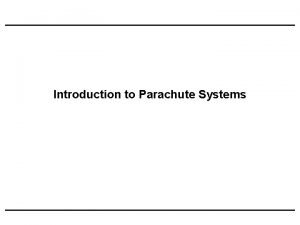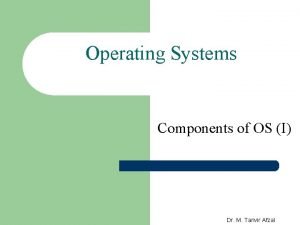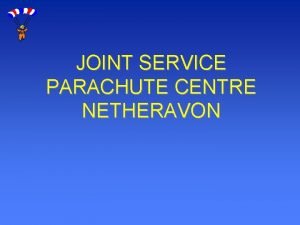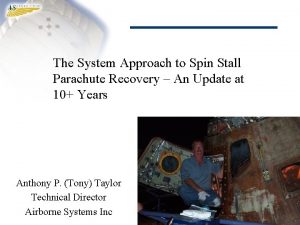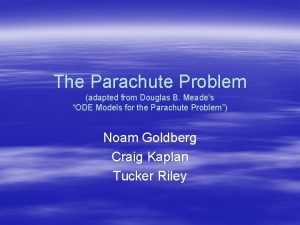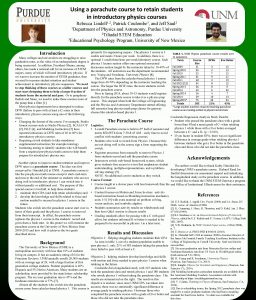Introduction to Parachute Systems Components of a Parachute
















- Slides: 16

Introduction to Parachute Systems

Components of a Parachute System Canopy: the major drag producing member of the parachute Vent: very upper region of the canopy, open to airflow Suspension Lines: load bearing members extending from the canopy to the payload Radials: load bearing member running from the suspension lines at the skirt to the vent lines Behr, V. and Potvin, J. , “Parachute Definitions, Nomenclature and Types, ” H. G. Heinrich Parachute Systems Short Course, 15 -19 May 2006. Gore: section of a parachute canopy between two radials Space Systems Engineering 2

Components of a Parachute System Pilot Parachute: a small parachute which is attached to a deployment bag or the vent of a larger parachute and is used to provide the force required to deploy a larger parachute. Drogue Parachute: a parachute which is attached to the payload and is used to provide stabilization or initial deceleration or both. Usually implies a larger parachute will be deployed later in the event sequence. Frequently used as the pilot parachute for the main parachute. Mars Pathfinder Drop Test suspension lines backshell Riser: a line connecting a parachute to its payload. May utilize a single or multi-point attachment scheme. Bridle: a means of providing a multi-point connection to a deployment bag or a vehicle from a parachute or riser. Space Systems Engineering canopy riser bridle MPF lander Witkowski, A. , “Mars Pathfinder Parachute System Performance, ” AIAA 99 -1701. 3

Components of a Parachute System Behr, V. and Potvin, J. , “Parachute Definitions, Nomenclature and Types, ” H. G. Heinrich Parachute Systems Short Course, 15 -19 May 2006. Cruz, J. R. , “Parachutes for Planetary Entry Systems, ” AE 8803 / Planetary Entry, Georgia Institute of Technology, Spring 2007. Deployment Bag: a textile container for a parachute from which the parachute deploys. It’s main purpose is to effect an organized deployment Space Systems Engineering 4

Components of a Parachute System Mortar: a deployment device used to eject a packed parachute from the payload as one mass to begin the deployment process. Mortars are the most common method of parachute deployment for spacecraft planetary entry. Example: Mortar Assembly for the Apollo Drogue Chute Knacke, T. W. , Parachute Recovery Systems Design Manual, Para Publishing, 1992. Space Systems Engineering 5

Typical Parachute Deployment Sequence Example from Mars Pathfinder Cruz, J. R. , “Parachutes for Planetary Entry Systems, ” AE 8803 / Planetary Entry, Georgia Institute of Technology, Spring 2007. Knacke, T. W. , Parachute Recovery Systems Design Manual, Para Publishing, 1992. Space Systems Engineering 6

Common Type of Parachutes & Their Uses Disk-Gap-Band (DGB) Ringsail Example spacecraft uses: Viking Landers Mars Pathfinder Mars Exploration Rovers Mars Phoenix Huygens Mercury main chutes Gemini main chutes Apollo CM main chutes Image from Mercury program Example spacecraft uses: Pioneer Venus Galileo Mercury drogue chutes Gemini drogue chutes Apollo CM drogue chutes Space Shuttle SRB chutes Image from Galileo wind tunnel test Image from MER wind tunnel test Cruz, J. R. , “Parachutes for Planetary Entry Systems, ” AE 8803 / Planetary Entry, Georgia Institute of Technology, Spring 2007. Ribbon http: // history. nasa. gov/SP-4001/images/fig 18. jpg Space Systems Engineering http: //solarsystem. nasa. gov/multimedia/gallery/ Galileo_Wind. Test. jpg 7

Successful Parachute Deployment Here are two videos that demonstrate successful parachute in a spacecraft related context: 1. Successful drop test from NASA Supersonic Planetary Entry Decelerator Program, SPED-1 (we’ll see some unsuccessful tests from this program a little later) (LV-2007 -00059) 2. Space Shuttle Solid Rocket Booster (SRB) parachute deployment Space Systems Engineering 8

Potential Failures (a partial list) There are many things that can lead to a parachute system failure. To help you gain a feel for the types of failure that may occur, let’s look at the following potential failure modes: • • Mortar doesn’t fire Aerodynamic loads exceed design Suspension lines become twisted or tangled Recontact with reentry and/or parachute hardware “Dumping” the canopy Asynchronous inflation of parachute clusters Squidding Wake recontact • And many more… Space Systems Engineering Example: Genesis Earth entry 9

Genesis Failure When the Genesis spacecraft returned to Earth on September 8, 2004, the parachutes failed to deploy. The spacecraft plunged into the Utah desert at 200 mph and broke apart. The redundant sets of switches controlling parachute deployment failed to respond to reentry deceleration because both sets were installed backwards as specified in the Lockheed-Martin design. http: //www. youtube. com/watch? v=e 875 O 0 h. Sces Text and images from the Design Fundamentals Lecture by L. Guerra Space Systems Engineering 10

Potential Failures (a partial list) There are many things that can lead to a parachute system failure. To help you gain a feel for the types of failure that may occur, let’s look at the following potential failure modes: • • Mortar doesn’t fire Aerodynamic loads exceed design Example: Drop test. After 1. 07 seconds of Suspension lines become twisted or tangled operation, a large tear appeared Recontact with reentry and/or parachute hardware in the cloth near the canopy apex. This tear was followed by two “Dumping” the canopy additional tears shortly thereafter. As a result of the damage to the Asynchronous inflation of parachute clusters disk area of the canopy, the Squidding parachute performance was significantly reduced; however, Wake recontact • And many more… the parachute remained operationally intact throughout the flight test and the instrumented payload was recovered undamaged. (LV-2007 -00064) Space Systems Engineering 11

Potential Failures (a partial list) There are many things that can lead to a parachute system failure. To help you gain a feel for the types of failure that may occur, let’s look at the following potential failure modes: • • Mortar doesn’t fire Aerodynamic loads exceed design Suspension lines become twisted or tangled Example: Recontact with reentry and/or parachute hardware Drop test. Parachute suspension lines get twisted because the “Dumping” the canopy partially inflated canopy could not restrict the twisting to the Asynchronous inflation of parachute clusters attachment bridle and risers. (LV-2007 -00052) Squidding Wake recontact • And many more… Space Systems Engineering 12

Potential Failures (a partial list) There are many things that can lead to a parachute system failure. To help you gain a feel for the types of failure that may occur, let’s look at the following potential failure modes: • • Mortar doesn’t fire Aerodynamic loads exceed design Suspension lines become twisted or tangled Recontact with reentry and/or parachute hardware Example: a. Drop test. One gore of the test “Dumping” the canopy parachute was damaged when Asynchronous inflation of parachute clusters the deployment bag with mortar lid passed through it from behind Squidding approximately 2 seconds after deployment was initiated. Wake recontact • And many more… (LV-2007 -00061) b. Apollo 15 Space Systems Engineering 13

Apollo 15 Main Parachute System Failure All three main parachutes deployed without incident at an altitude of 10, 000 ft One of the three parachutes deflated while the Apollo 15 capsule was obscured by clouds between 7, 000 ft and 6, 000 ft According to the “Apollo 15 Main Parachute Failure Anomaly Report No. 1” (NASA-TMX-6835): “The most probably cause of the anomaly was the burning of raw fuel (monomethyl hydrazine) being expelled during the latter portion of the depletion firing and this resulted in exceeding the parachute-riser and suspension-line temperature limits. ” http: //www. hq. nasa. gov/office/pao/History/alsj/a 15/ap 15 -S 71 -42217 HR. jpg Space Systems Engineering 14

Potential Failures (a partial list) There are many things that can lead to a parachute system failure. To help you gain a feel for the types of failure that may occur, let’s look at the following potential failure modes: • • Mortar doesn’t fire Aerodynamic loads exceed design Suspension lines become twisted or tangled Recontact with reentry and/or parachute hardware “Dumping” the canopy Asynchronous inflation of parachute clusters Squidding Wake recontact • And many more… Space Systems Engineering 15

Example of Wake Recontact Behr, V. and Potvin, J. , “Parachute Definitions, Nomenclature and Types, ” H. G. Heinrich Parachute Systems Short Course, 15 -19 May 2006. Space Systems Engineering 16
 Components of parachute
Components of parachute Components of operating systems
Components of operating systems Component of operating systems
Component of operating systems Components of operating systems
Components of operating systems Introduction to business information systems
Introduction to business information systems Medias system
Medias system Kelsey hayes abs module diagram
Kelsey hayes abs module diagram Components of operating systems
Components of operating systems 5 components of information system
5 components of information system Computer systems components
Computer systems components Component of research proposal
Component of research proposal Decision support systems and intelligent systems
Decision support systems and intelligent systems Dicapine
Dicapine Embedded systems vs cyber physical systems
Embedded systems vs cyber physical systems Engineering elegant systems: theory of systems engineering
Engineering elegant systems: theory of systems engineering Charles plumb
Charles plumb Léonard de vinci parachute
Léonard de vinci parachute
